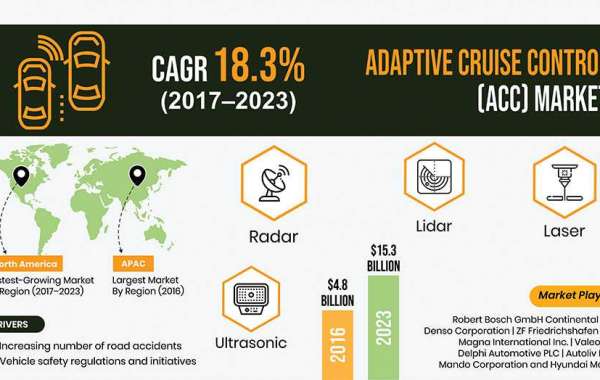From $4.8 billion in 2016, the global adaptive cruise control market is expected to attain the value of $15.3 billion by 2023, advancing at an 18.3% CAGR during the forecast period (2017–2023). The factors positively impacting the market growth are the rising number of vehicle safety initiatives and regulations due to the increasing number of road accidents. The adaptive cruise control (ACC) is meant to regulate the vehicle speed in order to maintain a safe distance from other vehicles on the road. It works by sensing the speed of vehicles and alerting the braking system to reduce the vehicle speed.
Based on application, the ACC market is bifurcated into passenger and light commercial vehicles. Of these, during the historical period (2013–2016), passenger vehicles dominated the market, and these are predicted to maintain their dominance during 2017–2023. This is attributed to the surging awareness among consumers about safety, increasing premium car sector, and formulation of strict norms by regulatory bodies, such as the New Car Assessment Program. Furthermore, the increasing demand for luxury cars in Asia-Pacific (APAC), specifically India and China, is predicted to contribute to the growth of the market.
Geographically, in 2016, North America and Europe collectively contributed more than 65.0% revenue to the adaptive cruise control market, and these are predicted to dominate the market during the forecast period as well. This is attributed to the increasing production of vehicles, technological developments, and strict safety regulations. The United States New Car Assessment Program (US NCAP) is encouraging people to install such systems in vehicles. Furthermore, the rapid integration of safety features in vehicles is leading to an improved rating system, which, in turn, would result in the market growth.
GLOBAL ADAPTIVEE CRUISE CONTROL MARKET SEGMENTATION
Original equipment manufacturers
Aftermarket
Additionally, the growing popularity of driver assistance systems in vehicles is expected to offer huge opportunities for the players operating in the ACC market. Companies such as BMW, Audi, Cadillac, and Volkswagen are heavily installing these systems in their various products. Besides, governments’ rising initiatives to lower the number of road accidents are predicted to surge the sales of driver assistance systems, which, in turn, would result in the growth of the market.
Thus, the increasing awareness about safety while driving, increasing adoption of advanced driver assistance systems, and stringent vehicle safety regulations and initiatives are the key factors helping the market grow.
